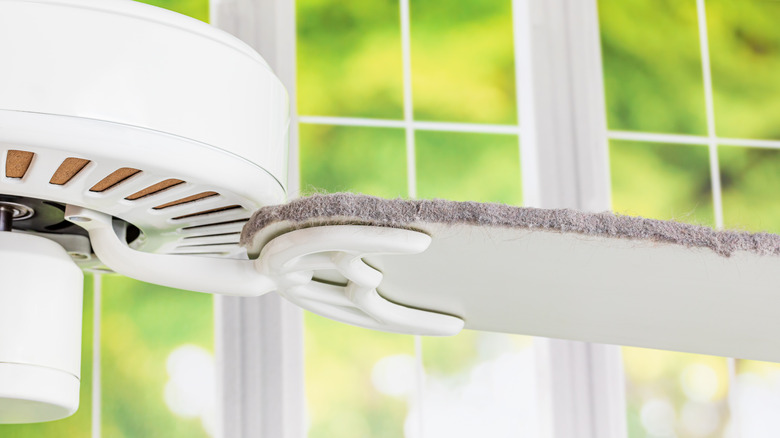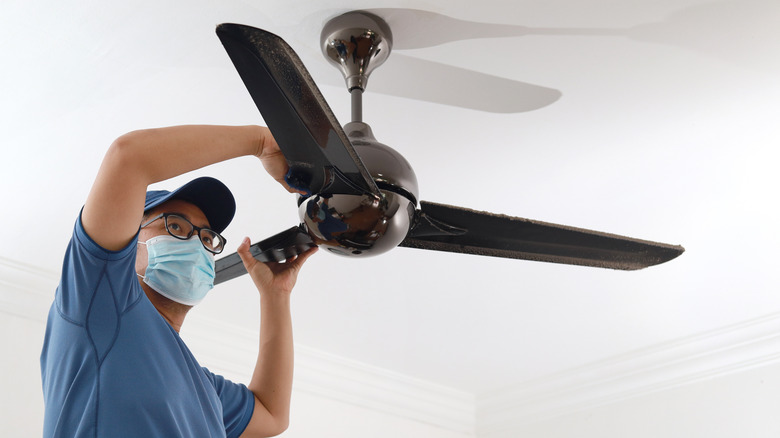This Brilliant Tip Will Change The Way You Clean Your Ceiling Fan Forever
We may receive a commission on purchases made from links.
Dirty ceiling fans — they're unavoidable, but so is cleaning them. Unfortunately, this is often a challenging part of your home to tackle, especially if you're looking to remove caked-on dirt and debris from the top of each fan blade. Sure, you can grab a step stool, some paper towels, and your favorite non-toxic cleaning product, such as vinegar, a versatile cleaning tool. But this often results in dirt being transferred around your room, especially if you miss a spot and it comes flying off the moment you turn your fan on. Fortunately, you can remove grime from all angles of your ceiling fan with nothing more than a sock and clothespins.
Before you get cleaning, you need to spray your sock with a cleaning product. What you use is just as important as the tools themselves, and it's a good idea to make your own DIY cleaning spray. First, it saves you money. Second, DIY sprays allow you to control the ingredients, avoiding nasty, harmful chemicals such as ammonia and other toxic chemicals. This is especially true if you have children or pets in your home, or simply want to improve your indoor air quality. That's right — according to the EPA, indoor air quality can be up to 100 times worse than outdoor air quality. Seeing as cleaning products can increase indoor air pollution, the best way to protect yourself and your family is with non-toxic cleaners. And what better time to use them than when cleaning your ceiling fans?
Clothespin a sock to your ceiling fan
To carry out this hack, grab some old socks and clothespins. If you don't have any old socks available, you can purchase a 10-pack on Amazon for $19. You can also purchase a 50-pack of clothespins for $8 on Amazon. These particular clothespins come in rainbow colors, which means you can reuse them for crafts with the kiddos. You can also find plenty of ways to use clothespins in your home and garden, meaning the materials for this ceiling fan cleaning hack will have tons of other practical purposes around the home.
Once you gather your materials, spread your sock flat on a surface and spray one side of it with your non-toxic cleaner. Next, fold your sock over your ceiling fan blade and clamp it shut with your clothespin. Run it up and down the length of each fan blade, collecting dirt and dust as you go. If your sock becomes too saturated with gunk, swap it out for a clean one. You can also flip it inside out. If your fan isn't too dirty, you might be able to use one or two socks for the entire cleaning process. Once your fan is free from dirt, wash your socks and put them with the rest of your cleaning items. You can even use them to dust other areas of your home, making this a hack that alleviates the need to buy a ton of different cleaning products.
Take precautions when cleaning ceiling fans
When cleaning your ceiling fan, you need to take precautions to ensure your safety. For starters, you may want to wear a mask. This works to prevent the accidental inhalation of dust particles. This is especially true if you have allergies or asthma. Next, ensure your step stool is solid and sturdy. Your step stool's base should be open as far as it goes, locking its spreaders in place. If they're not locked or jammed, don't climb on your step stool. Additionally, you should always be off your step stool before attempting to move it from one area to another. If you have vaulted ceilings and you need a ladder, always have someone hold the bottom of it for you, securing your ladder in place.
Next, be mindful of your ceiling fan's blades when cleaning. You don't want to pull or tug them, so exercise caution to avoid damaging your fan while removing dust and dirt. If your ceiling fan has glass shades on it, you may want to remove them as well, ensuring all surfaces are clean. Once removed, be sure to place these shades in a safe place so you don't accidentally break them. Some people even recommend letting them soak in water with denture tablets to remove caked-on grime. This is especially true for ceiling fans near kitchen stoves, as they're more prone to grease, oil, and food splatter accumulation. Once your ceiling fan is clean, it should work more efficiently.

